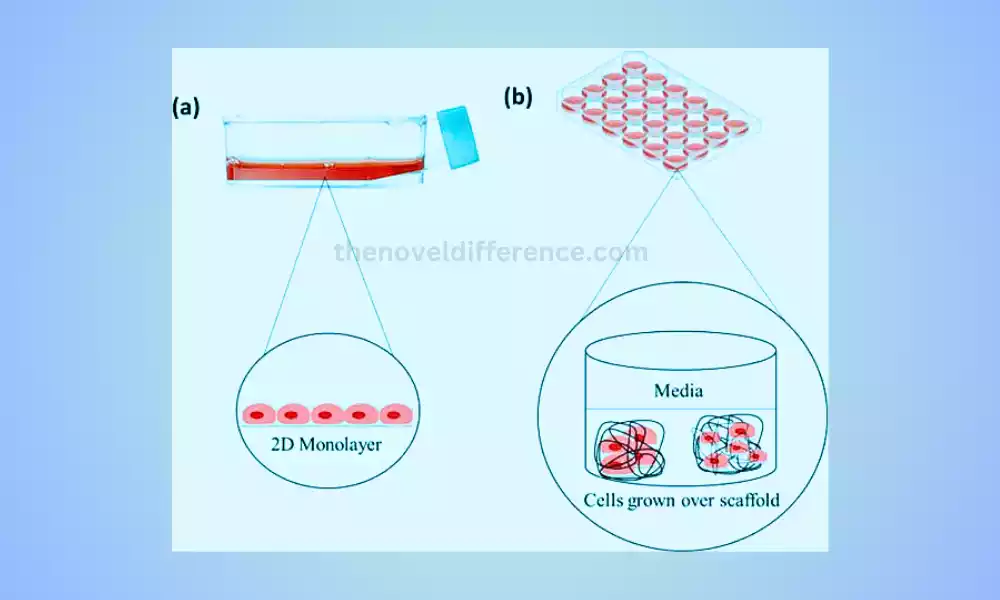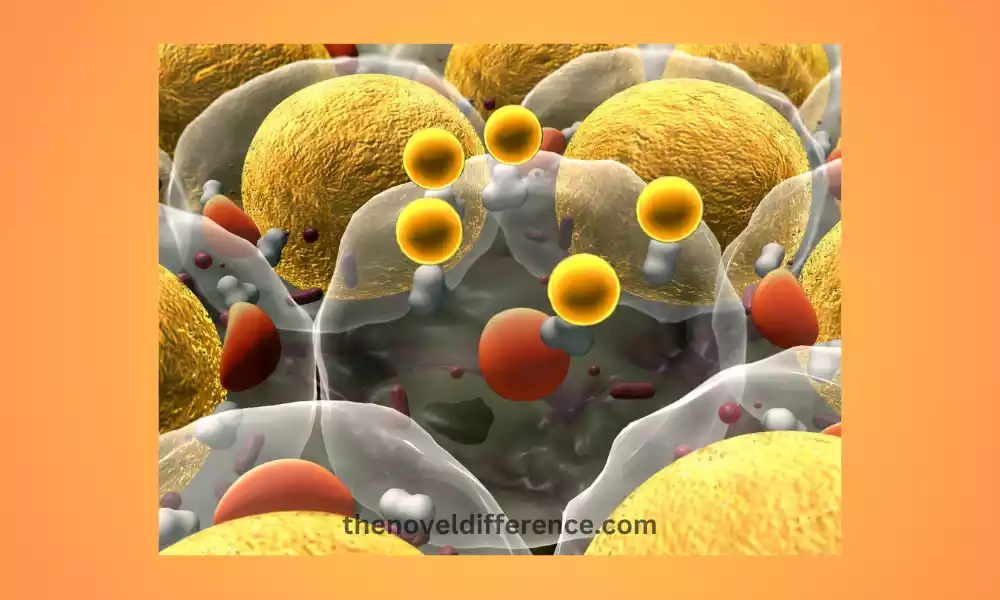The main difference between 2D and 3D cell culture is that 2D cell culture usage an artificial flat surface. Usually, a petri dish or a cell culture plate is usage while 3D cell culture uses a substrate. thereby mimicking the extracellular matrix of that particular cell type.
Cell culture is a process that typically involves growing cells under controlled conditions outside of their physical environment. There are two types of cell culture, 2D and 3D.
Both of them 2D and 3D cell culture systems are very useful in in-vitro testing of therapeutics drugs and other biochemically active compounds.
Importance of 2D Cell Culture
2D cell culture has played an important role in advancing scientific research and our understanding of cellular behavior. Its importance lies in its simplicity, versatility, and historical significance. By culturing cells on flat surfaces or substrates such as Petri dishes or culture flasks, researchers are able to conduct high-throughput experiments and basic cellular studies.
This technique has been instrumental in elucidating fundamental biological processes such as cell proliferation, differentiation, and apoptosis. The controlled environment of 2D cultures allowed precise manipulation of experimental variables. Enables detailed investigation of cellular responses to various stimuli.
2D cell culture has also been a cornerstone in drug development and toxicity screening. Its ease of use and cost-effectiveness make it a primary choice for conducting initial drug trials and identifying potential compounds for further investigation.
The monolayer culture setup facilitates the observation of changes in cellular morphology. Allows straightforward analysis of cell growth and viability. The ability to perform genetic and molecular studies on cells in a controlled, two-dimensional context has contributed to significant advances in our understanding of diseases and their underlying mechanisms.
Importance of 3D Cell Culture
3D cell culture has emerged as a revolutionary technique that addresses the limitations of traditional 2D culture systems. Provides a more physiologically relevant environment for studying cell behavior. Its importance stems from its ability to better mimic the complex three-dimensional structures and interactions found in living organisms.
Provides cells with a more native-like microenvironment. which has opened up new avenues in various fields of 3D cell culture research. One of the main advantages of 3D cell culture is the potential to bridge the gap between in vitro studies and in vivo conditions.
Cells grown in three-dimensional arrays, such as spheroids, organoids, or hydrogels, more accurately represent the complexity of tissues and organs. These advances have improved disease modeling, enabling researchers to better understand disease progression and mechanisms.
In drug development, 3D cell culture provides more predictive models of drug responses. Revolutionized pre-clinical testing, leading to more accurate identification of effective compounds and reducing the number of failed clinical trials.
What is 2D Cell Culture?
2D cell culture, also known as two-dimensional cell culture. On a flat surface, usually refers to the practice of growing and maintaining cells in culture dishes, flasks, or multiwell plates. In this technique, cells adhere to the substrate and spread.

forming a monolayer in which they interact with the surrounding environment in a simplified, planar arrangement. Cells are usually in a nutrient-rich medium that contains nutrients, growth factors, and other necessary components to support their growth and proliferation.
In 2D cell culture, cells are exposed to a constant supply of nutrients and oxygen from the culture medium, and waste products are removed by the medium exchange. Researchers often use adherent cell lines, which naturally adhere to the substrate.
which makes it easier to maintain the monolayer configuration. So, non-adherent cells can also be cultured in 2D using special techniques and coatings to promote adhesion.
What is 3D Cell Culture?
3D cell culture is an innovative approach that seeks to replicate the complex three-dimensional architecture and interactions found in living tissue within a laboratory setting. Unlike traditional 2D cell culture, where cells grow on flat surfaces.

3D cell culture arranges cells in a way that more closely mimics the natural microenvironment of cells in the body. This can be achieved through different techniques, such as the formation of cell aggregates (spheroids). Cell cultures within hydrogels or growing organoids – miniature versions of organs with cellular diversity and functionality.
The goal of 3D cell culture is to provide cells with a more physiologically relevant environment. thereby allowing for a better representation of cellular behavior, gene expression, and interactions as they occur in living organisms. This technique provides more accurate insight into complex biological processes.
So, enabling the development of advanced preclinical models that closely resemble in vivo conditions has revolutionized fields such as disease modeling, drug screening, tissue engineering, and regenerative medicine.
Difference Between 2D and 3D Cell Culture
| Aspect | 2D Cell Culture | 3D Cell Culture |
|---|---|---|
| Cell Growth | Cells grow in monolayers on flat surfaces. | Cells grow in three-dimensional structures or aggregates. |
| Morphology | Flattened and elongated cell shape. | More natural and varied cell shapes, resembling in vivo conditions. |
| Microenvironment | Simplified and uniform environment. | Mimics complex tissue microenvironments, including cell-cell and cell-matrix interactions. |
| Cellular Behavior | Altered gene expression and behavior compared to in vivo conditions. | More physiologically relevant gene expression and cellular responses. |
| Drug Testing | Initial drug screening and high-throughput assays. | Improved predictive models for drug efficacy and toxicity testing. |
| Disease Modeling | Limited representation of disease mechanisms. | Enhanced disease modeling with a closer resemblance to in vivo conditions. |
| Tissue Engineering | Limited ability to create functional tissues. | Enables the creation of tissue constructs and organoids for regenerative medicine. |
| Personalized Medicine | Limited applicability due to uniform conditions. | Enables patient-specific models and personalized treatment strategies. |
| Cell-Cell Interactions | Minimal representation of complex cellular interactions. | Provides insight into cell-cell interactions and cellular heterogeneity. |
| Complexity | Less complex and controlled environment. | More complex and diverse microenvironments and cell arrangements. |
| Equipment and Expertise | Relatively straightforward and requires basic equipment. | May require specialized techniques and equipment. |
| Ethical Considerations | Often used in the absence of alternative methods. | Holds the potential to reduce animal testing and ethical concerns. |
This chart provides a concise overview of the key differences between 2D and 3D cell culture techniques, emphasizing their respective advantages and applications in various research areas.
Applications of 2D and 3D Cell Culture
Applications of 2D Cell Culture:
- Basic Cellular Research: 2D cell culture remains essential for understanding fundamental cellular processes, such as cell proliferation, differentiation, apoptosis, and cell cycle dynamics. Its simplicity and controllability make it a suitable platform for studying these core mechanisms.
- High-Throughput Screening: The flat and uniform nature of 2D cultures makes them ideal for high-throughput drug screening and compound testing. Large-scale experiments can be conducted to identify potential drug candidates quickly and efficiently.
- Cell Signaling Studies: Researchers can investigate cellular signaling pathways, including protein-protein interactions and gene expression profiles, using 2D cell cultures. These studies contribute to our understanding of cellular communication and regulatory mechanisms.
- Cancer Research: 2D cultures have been instrumental in cancer research, aiding in the study of cancer cell behavior, metastasis, drug resistance, and potential therapeutic targets.
- Virus Propagation: Many viruses are propagated and studied in 2D cell culture systems, which allow researchers to understand viral replication, pathogenesis, and the development of antiviral therapies.
Applications of 3D Cell Culture:
- Disease Modeling: 3D cell culture models provide a more realistic platform for studying diseases, allowing researchers to recreate complex tissue microenvironments and investigate disease mechanisms. This is particularly relevant for studying cancer, neurodegenerative disorders, and infectious diseases.
- Drug Development: 3D cell cultures offer improved predictive models for drug efficacy and toxicity testing. The more accurate representation of in vivo conditions helps identify promising drug candidates and assess potential side effects.
- Tissue Engineering and Regenerative Medicine: Organoids and tissue constructs grown using 3D cell culture techniques hold promise for developing functional tissues and organs for transplantation, reducing the need for traditional organ donors.
- Personalized Medicine: 3D cultures derived from patient cells can be used to create patient-specific models for drug testing, enabling personalized treatment strategies that consider individual genetic variations and disease profiles.
- Cell-Cell Interactions: 3D cell cultures facilitate the study of cell-cell interactions and cellular heterogeneity, offering insights into how different cell types collaborate or compete within complex tissues.
- Stem Cell Research: Organoids and 3D cultures provide a suitable environment for the differentiation and maturation of stem cells into specific cell types, aiding in the study of developmental biology and potential therapeutic applications.
- Microenvironment Studies: Researchers can investigate the influence of extracellular matrix, mechanical forces, and other microenvironmental factors on cellular behavior in 3D cultures, contributing to our understanding of tissue physiology.
Both 2D and 3D cell culture techniques have a range of applications, each offering unique advantages based on the research goals. While 2D cultures excel in simplicity and high-throughput capabilities, 3D cultures provide more physiologically relevant insights, particularly in disease modeling, drug development, and tissue engineering.
Conclusion
In the ongoing pursuit of understanding cellular behaviors, the Difference Between 2D and 3D Cell Culture is a topic of paramount importance. Both techniques offer unique insights into cellular responses, each with its own strengths and limitations. As scientific advancements continue, researchers find new ways to harness the potential of these methodologies, propelling our understanding of cell biology to unprecedented heights.
